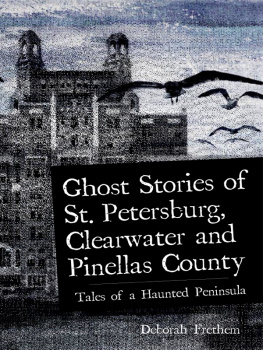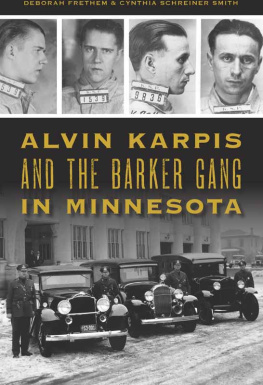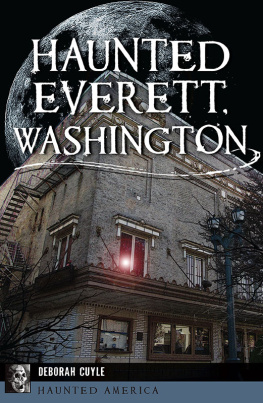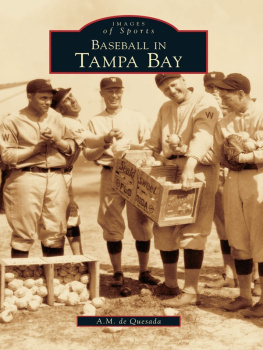
Published by Haunted America
A Division of The History Press
Charleston, SC 29403
www.historypress.net
Copyright 2013 by Deborah Frethem
All rights reserved
First published 2013
e-book edition 2013
Manufactured in the United States
ISBN 978.1.62584.689.1
Library of Congress Cataloging-in-Publication Data
Frethem, Deborah.
Haunted Tampa : spirits of the bay / Deborah Frethem.
pages cm
Includes bibliographical references.
print edition ISBN 978-1-62619-213-3 (paperback)
1. Ghosts--Florida--Tampa--Anecdotes. 2. Haunted places--Florida--Tampa--Anecdotes. 3. Historic buildings--Florida--Tampa--Anecdotes. 4. Tampa (Fla.)--Social life and customs--Anecdotes. 5. Tampa (Fla.)--Buildings, structures, etc.--Anecdotes. I. Title.
BF1472.U6F776 2013
133.10975965--dc23
2013032989
Notice: The information in this book is true and complete to the best of our knowledge. It is offered without guarantee on the part of the author or The History Press. The author and The History Press disclaim all liability in connection with the use of this book.
All rights reserved. No part of this book may be reproduced or transmitted in any form whatsoever without prior written permission from the publisher except in the case of brief quotations embodied in critical articles and reviews.
For Signe, the light of my life.
And for Craig, now and forever.
CONTENTS
ACKNOWLEDGEMENTS
Sincere thanks to the staff of the Tampa Theatre, especially Jill Witecki, John Bell and former staff member Tara Schroeder; to all the many students and former students of the University of Tampa who have shared their stories with me over the years; to the Tampa History Center Research Library, especially David and Phyllis; to Paul Guzzo, for his information and inspiration regarding Charlie Wall; to Michelle, Derek, Jensen and Forest of Duckweed Urban Market; to the staff of the Hotel Floridan, especially April, Daniel, Costa and, of course, Tony at the piano; to Lynn Brown, for believing in me; to Donna and Steve Bremer, who first helped me to become a writer; to Tim Reeser, for allowing me to tell ghost stories on the streets of Tampa; and most of all to Craig, for photographic and technical support, holding my hand or kicking my rear as needed.
INTRODUCTION
A CITY BUILT ON BONES
The Spanish conquerors called the bay Bahia de Espiritu Sancto, or the Bay of the Holy Spirit. It is said that history is written by the winners, but in this case, it was the ancient name of the bay that survived, long after the Spanish name was forgotten. The Calusa, a native tribe from the southern part of what is now Florida, called the bay Tampa. In their language, the word means sticks of fire or place of lighted sticks, most likely a reference to the thousands of lightning strikes that hit the area every year.
Before the arrival of the Spanish in the sixteenth century, the Florida peninsula was home to several different Native American tribes. One ancient tribe had villages along what we now call the Hillsborough River, at the spot where that river meets Tampa Bay. This was the Tocobaga tribe. Some archaeologists believe that they were here for as long as ten thousand years before the arrival of the Spanish. A peaceful people, they had only rudimentary agriculture and ate primarily shellfish. During the years they lived around the bay, they would take the shells from those oysters, scallops and clams and pile them in central locations, creating huge shell mounds, some over fifty feet high. They used these mounds for many things, often building temples and homes for the chiefs at the apex. But the most important use for these mounds was as burial sites. When a member of the tribe passed away, the body would be carefully and lovingly laid out on a platform of palmetto fronds. The mourners would then wait for the elements and bugs, birds and rats to do their work. When the bones were picked clean, they were wrapped in ceremonial clothes and buried within the shells. At one time, such burial mounds existed all around Tampa Bay. A mound over fifty feet high and two city blocks long stood in what is now downtown Tampas Lykes Gaslight Park, south of Franklin between Madison and Kennedy Avenues. The population of the Tocobaga was decimated by the diseases brought by the Spanish Conquistadors. Today, the tribe is believed to be extinct.
In the early 1700s, another band of Native Americans came to the area. They were renegade Creeks from farther north. The Spaniards called them the Cimaronnes, meaning wild ones. Today, we know them as the Seminoles. When they came to the area, they respected the cultures that had preceded them. So they left the shell mounds undisturbed.
In the early 1800s, when the first European American settlers arrived looking for a permanent home, the shell mounds still stood proud and tall. But those roads in early Tampa were made of dirt, and when the summer rains came, the roads became impassable mud. The shell mound seemed like a convenient fill to make it easier for horses, mules and oxen and the carts they pulled to pass through the streets. The mounds were torn down, bones and all, and scattered into the mud. And the bones still lie on those early streets. Over the years, the bones were covered with cobblestones. Eventually, those roads were paved over to make the streets we have today. Thus, it is no wonder that Tampa is a haunted city. It is, quite literally, a city built on bones.
Along the shores of the Hillsborough River, in front of the University of Tampas Plant Hall, stands a steel sculpture that shimmers in the sunlight. Done by sculptor O.B. Shaffer, it appears very modern, but its upward-reaching bands are there to represent the name given by the Calusa so long ago: Tampa, sticks of fire!
PART I
EARLY DAYS
FORT BROOKE
For about one hundred years, the Seminoles lived peacefully in Florida, but by the early nineteenth century, the white man had set his sights on their sunny peninsula. Florida became a territory of the United States in 1822. The ink was barely dry on the treaty with Spain when the United States decided to establish a military presence near the mouth of the Hillsborough River. On January 10, 1824, Colonel George Mercer Brooke and four companies of the Fourth U.S. Infantry arrived at the selected site. A wooden fort was constructed from local materials. Originally called Cantonment Brooke, it became Fort Brooke later that same year.
Among the soldiers stationed at Fort Brooke was a young officer and graduate of West Point named George A. McCall. While serving in Florida, he wrote many letters home to his family. These letters were preserved and later gathered together and published under the title Letters from the Frontier. In a letter to his father, dated March 28, 1824, George recounts what may be Tampas earliest recorded ghost story.
At about 9:30 on a foggy morning, one of the sentinels, who had climbed to the top of a huge live oak for a sweeping view of all of Tampa Bay, suddenly called out, Sail ho! Officers and men, some carrying telescopes, hurried to the shore and saw sails on the horizon. Was it four ships or five? It was hard to tell at a distance. But as the ships continued to come nearer and nearer, they could clearly discern the sails of five ships. Uncertain as to just who might be in these ships, Colonel Brooke decided to go out and meet them and ordered refreshments to be prepared to welcome their guests, whoever they may be. But as the commander and several other soldiers were getting into a small boat to row out to meet the ships, one of the soldiers cried out, Where, where are the vessels?








